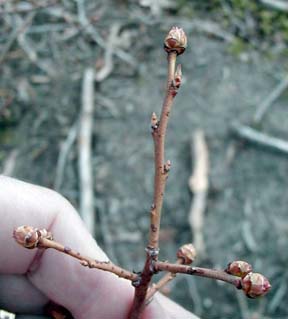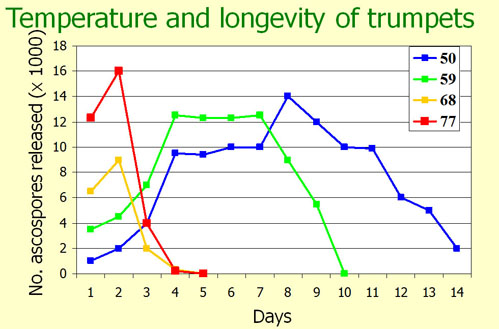Understanding mummy berry shoot strikes
Understanding this common blueberry disease helps achieve control.
Plant diseases often have unusual lifestyles. Mummy berry needs to infect blueberries twice every year to survive. Initially spores from the overwintering mummies need to infect the new growing shoots. Then spores from the shoot strikes need to infect the flowers and fruit to form the overwintering mummies.
The overwintering mummies need moisture and a cold period of at least 900 to 1,200 chill hours (hours with temperatures between 32° and 45°F [0° and 7°C]). This range is similar to that required by blueberries to complete their winter dormancy and ensures that they begin growth together in the spring. Wet winters and especially snow cover increase winter survival of the mummies.

Blueberries are susceptible to mummyberry infection in the early spring.
In early spring, the overwintering mummies in blueberry fields sprout little trumpet-shaped fruiting bodies called apothecia, or more commonly mushrooms or trumpets. Mummies can produce up to ten trumpets in a season. In the blueberry fields of Southwest Michigan, you can find tiny brown initials are emerging from the mummies. The ends of these initials already have a small pore in them. The tips of these apothecia expand, becoming goblet shaped. As the hole in the end of the stipe expands to 1/12 inch (2 mm) in diameter, they start to eject ascospores into the air. As apothecia expand, the number of spores released increases. Spore discharge depends on wind speed, temperature and relative humidity. Ascospores tend to be discharged in the late morning when relative humidity drops and wind speed picks up. Apothecia can persist for three weeks under cool conditions, but persists for only a week under warmer temperatures.

Trumpet Longevity from Wharton and Schilder.
As the leaf buds expand, exposing green tissue, they become susceptible to infection by ascospores from the apothecia. The ascospores are carried to the expanding buds by air currents and need free water for germination. The optimum temperature for infection is 57°F (14°C). At 57°F, with adequate moisture, germination and infection can occur within 4 hours; at 36°F (2°C), at least 10 hours of leaf wetness are required for infection.
|
Wetness |
Temperature (ºF) During Wet Period |
||||
|
Duration (h) |
36 |
43 |
50 |
57 |
65 |
|
2 |
0 |
0 |
0 |
0 |
0 |
|
4 |
0 |
0 |
0 |
0 |
0 |
|
6 |
0 |
Low |
Low |
High |
High |
|
8 |
0 |
Mod |
High |
High |
High |
|
10 |
Mod |
High |
High |
High |
High |
|
15 |
Mod |
High |
High |
High |
High |
|
24 |
High |
High |
High |
High |
High |
Table source: Paul Hildebrand, Ag Canada, Nova Scotia.
Young tissues are more susceptible to infection after exposure to freezing temperatures. This susceptibility can last for up to 4 days after the freeze event.
The number of shoot strikes in a field is often related to the number of apothecia in the field. Lots of mummies and trumpets means lots of shoot strikes. Since the ascospores are dispersed by the wind they can move a good distance from the apothecia and spores can blow in from neighboring fields or from escaped bushes around the field. Growers should monitor their fields for mummy berry trumpets and watch the weather to anticipate disease infection periods. The Multi-Crop Disease Summary tool in the fruit section of MSU’s website, Enviroweather, can be used to estimate the hours of wetness and the duration of a wetting event. This allows growers to determine the disease risk during or soon after wetting events.
Also see Scouting and management of mummy berry in blueberries by Annemiek Schilder.



 Print
Print Email
Email